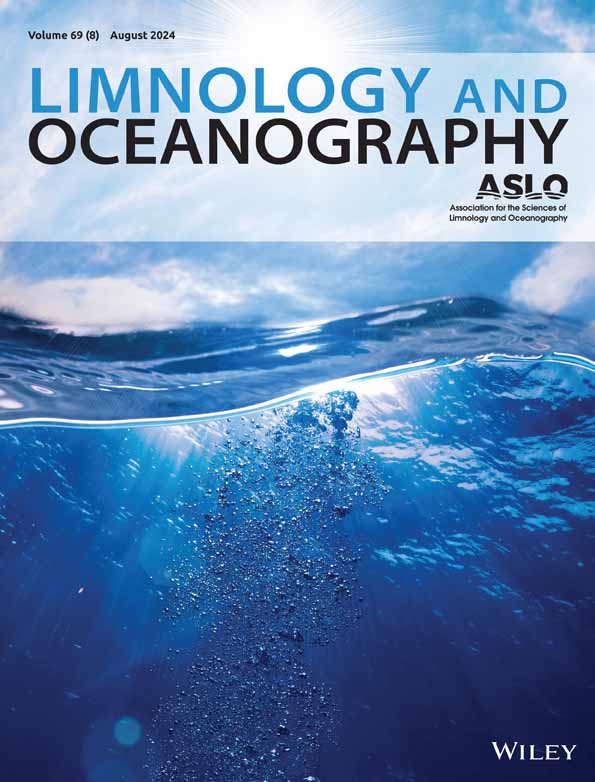Primary production drives varied zooplankton migration strength and twilight‐zone particle dynamics across ecological gradients in the western North Pacific
IF 3.8
1区 地球科学
Q1 LIMNOLOGY
引用次数: 0
Abstract
Diel vertical migrations (DVM) of zooplankton play a crucial role in transferring organic matter efficiently to the deep ocean. However, the spatial regulatory determinants of DVM strength, including migrant biomass and migration amplitude, remain understudied. We conducted 34 stratified trawls and 85 Underwater Vision Profiler 5 casts across latitudes 12.5°N to 41.5°N in the western North Pacific and developed a structural equation model to explain DVM variability relative to measured and remotely sensed environmental data. Migrant biomass was mainly determined by net primary productivity (NPP), being two orders of magnitude greater in high NPP waters due to higher zooplankton biomass and larger migrating individuals. Migration amplitude was also larger at high NPP stations but was determined by a direct negative correlation to euphotic zone depth and an offsetting indirect positive interaction with water clarity. Migration patterns reflect the classic tradeoff between predation risk and reduced daytime feeding for regular DVM and likely avoidance of mesopelagic visual predators at night for reverse migrants. In high‐resolution profiles, particle abundances and large particle contributions increased in the twilight zone during the daytime, generally aligning with biomass distributions and respiratory fluxes of migratory zooplankton. Migrants likely contribute to mesopelagic particle dynamics with pulsed fecal matter delivery from the euphotic zone and direct interactions with deep particle fields. Mesopelagic particle dynamics might also be linked to deep migrant mortality, the least quantified component of the biological carbon pump.初级生产驱动了北太平洋西部不同生态梯度的浮游动物迁移强度和暮光带颗粒动力学
浮游动物的垂直迁移在向深海有效转移有机物方面起着至关重要的作用。然而,DVM强度的空间调控决定因素,包括迁移生物量和迁移幅度,仍未得到充分研究。我们在北太平洋西部的纬度12.5°N至41.5°N范围内进行了34条分层拖网和85条水下视觉剖面仪5投鱼,并建立了一个结构方程模型来解释相对于测量和遥感环境数据的DVM变化。洄游生物量主要由净初级生产力(NPP)决定,在NPP高的水域,由于浮游动物生物量高,洄游个体多,净初级生产力要高两个数量级。在高NPP站点,迁移幅度也较大,但由与透光带深度的直接负相关和与水清晰度的间接正相互作用决定。迁徙模式反映了在捕食风险和减少白天摄食之间的经典权衡,对于常规DVM来说,在夜间可能避免中上层视觉捕食者。在高分辨率剖面中,颗粒丰度和大颗粒贡献在白天黄昏区增加,与生物量分布和洄游浮游动物的呼吸通量基本一致。迁移者可能通过从透光区的脉冲排泄物输送和与深层粒子场的直接相互作用来促进中层粒子动力学。中远洋颗粒动力学也可能与深层迁移者死亡率有关,这是生物碳泵中量化最少的组成部分。
本文章由计算机程序翻译,如有差异,请以英文原文为准。
求助全文
约1分钟内获得全文
求助全文
来源期刊

Limnology and Oceanography
地学-海洋学
CiteScore
8.80
自引率
6.70%
发文量
254
审稿时长
3 months
期刊介绍:
Limnology and Oceanography (L&O; print ISSN 0024-3590, online ISSN 1939-5590) publishes original articles, including scholarly reviews, about all aspects of limnology and oceanography. The journal''s unifying theme is the understanding of aquatic systems. Submissions are judged on the originality of their data, interpretations, and ideas, and on the degree to which they can be generalized beyond the particular aquatic system examined. Laboratory and modeling studies must demonstrate relevance to field environments; typically this means that they are bolstered by substantial "real-world" data. Few purely theoretical or purely empirical papers are accepted for review.
 求助内容:
求助内容: 应助结果提醒方式:
应助结果提醒方式:


